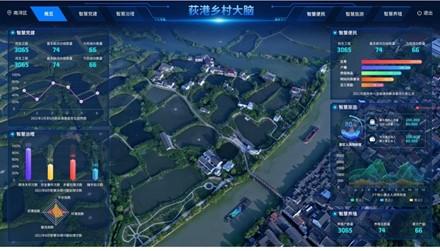Traditional fisheries are profoundly affecting the world’s environmental sustainability because of overfishing and shrinking aquatic habitats. Against this backdrop, digital fishery offers a new solution to the trade-off between the growing supply of aquatic products and the degrading ecosystem. The practice at Digang Village in China’s southeastern Zhejiang Province is at the forefront of the digital fishery field, as well as other digital explorations in rural China.
Digang is known as the “Ancient Fish and Mulberry Town of China” and is also the heritage site of “Huzhou Mulberry-dyke & Fish-Pond System”, one of the Globally Important Agricultural Heritage Systems (GIAHS).

Digitalization can promote the high-quality development of fisheries. To upgrade the fishery industry and keep pace with China’s social and economic development, Digang Village has introduced several high-tech fishery enterprises. The new mode of fisheries fostered by digital services has driven the farming transformation of more than 2,000 households. By integrating agricultural resources, the digital supply chain allows city dwellers to buy aquatic products online conveniently. This gives a boost to the sale of local aquatic products, facilitates brand building and propels the development of modern fisheries in surrounding areas.
First, digitalization promotes the transformation of fishery production.Fish ponds are monitored and controlled in a digital and intelligent way, being equipped with automatic feeding machines, remote automated control systems, water quality monitoring devices, etc.
Second, socialized services protect fishermen from related risks. The grid-based smart farming service standards have been established, and a digital monitoring and service system that combines farm attendants and online AI-enabled management has been improved. This enables farmers to monitor the water quality (dissolved oxygen, ammonia nitrogen, nitrite, PH value, etc.) in an accurate, efficient and standard manner. These services greatly reduce the risk in breeding, mitigate labor intensity and improve the production efficiency.
Third, the e-commerce platform helps secure the supply of aquatic products. The platform connects farmers and retailers, e.g., online retailers, traditional supermarkets and restaurants. It has a variety of features, such as supply and demand matching, online order management, transaction management, supply chain information management, payment management and quality traceability, and provides a highly reliable aquatic product sales channel for farmers.
Fourth, digital fishery facilitates big data decision making. The mobile application “Qing Yu Tang” is a region-wide aquaculture information and big data analysis platform that provides farmers with technical guidance and professional big data consulting services in fisheries. The platform can also assist local governments with fisheries management by providing such information as the distribution of fishery resources and development trends in fisheries. In short, it can significantly improve farmers' managerial and technical capacities while increasing the government's management efficiency. In the future, the adoption of digital technology will bring about greater changes to the way of production and lifestyle of farmers.
Excerpt from: Sci-Tech Empowering Rural Transformation Report 2022: Digital Technology Empowers Agricultural Value Chain Development
Category
Digitalization Becomes the New "Net" for Fisheries
Contributor
Digitalization Becomes the New "Net" for Fisheries
Country
Case Study

